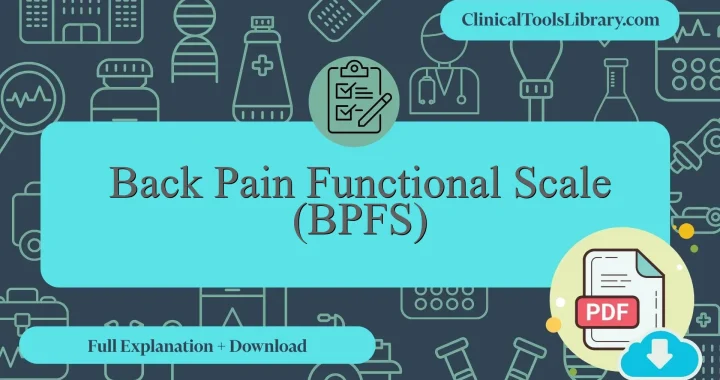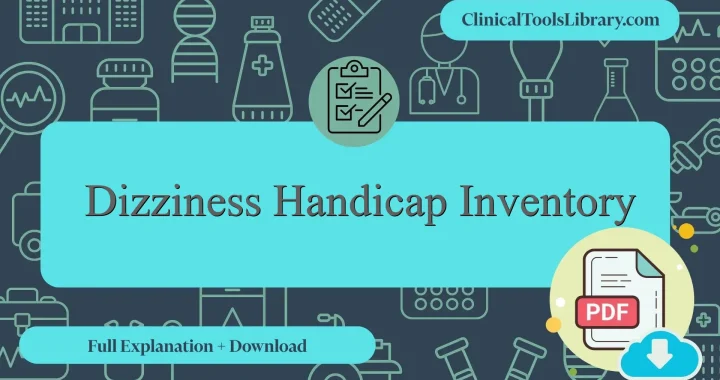In this article, we explain everything you need to know about the Community Balance and Mobility Scale (CB&M). We will cover the aspects it evaluates, the target population, a detailed step-by-step explanation, and how to interpret its results. Additionally, we will dive into the scientific evidence supporting this tool (diagnostic sensitivity and specificity) in clinical assessment. You will also find official and unofficial sources available for download in PDF format.
What does the Community Balance and Mobility Scale (CB&M) assess?
The Community Balance and Mobility Scale (CB&M) is a high-level mobility assessment tool designed to evaluate complex balance and mobility tasks in individuals with neurological and orthopedic conditions. Its primary purpose is to identify subtle impairments in dynamic balance and functional mobility that are not detected by more conventional assessments such as the Berg Balance Scale or the Dynamic Gait Index. The CB&M includes tasks that challenge postural control during activities commonly encountered in the community, thereby providing a comprehensive measure of an individual’s ability to navigate environments safely. Clinicians often refer to the Community Balance and Mobility Scale scoring system to quantify performance objectively, with established Community Balance and Mobility Scale cut off scores guiding clinical decision-making. This scale is particularly useful for patients recovering from stroke, traumatic brain injury, or other conditions affecting balance and ambulatory function. Resources such as the Community Balance and Mobility Scale pdf and instructional materials including a Community Balance and Mobility Scale video facilitate standardized administration and interpretation of results.
For which type of patients or populations is the Community Balance and Mobility Scale (CB&M) intended?
The Community Balance and Mobility Scale (CB&M) is primarily indicated for individuals with mild to moderate balance impairments, particularly those recovering from stroke, traumatic brain injury, or neuromuscular disorders. It is most useful in clinical contexts requiring the assessment of higher-level functional balance and mobility tasks that are not captured by traditional measures such as the Berg Balance Scale or Dynamic Gait Index. This scale is valuable for evaluating community-dwelling patients who demonstrate near-normal gait but remain at risk for falls due to subtle deficits in dynamic and complex movement patterns. The CB&M’s sensitivity to changes in balance and mobility makes it an essential high-level mobility assessment tool for planning targeted rehabilitation interventions and monitoring progress during outpatient or home-based therapy. Clinicians often refer to the Community Balance and Mobility Scale scoring protocols to ensure standardized administration and interpretation.
Step-by-Step Explanation of the Community Balance and Mobility Scale (CB&M)
The Community Balance and Mobility Scale (CB&M) consists of 13 items designed to assess dynamic balance and mobility in community-dwelling adults, particularly those with neurological impairments such as stroke and traumatic brain injury. The clinician administers a series of functional tasks, including walking, stair climbing, and multitasking activities that challenge both balance and coordination. Each item is scored on a 6-point ordinal scale ranging from 0 to 5, reflecting the quality and control of movement, with higher scores indicating better performance. The total score spans from 0 to 96, providing a comprehensive measure of a patient’s ability to perform complex mobility tasks safely in everyday environments. The administration protocol requires minimal equipment and typically takes 20-30 minutes to complete, allowing for standardized evaluation and monitoring of progress in rehabilitation settings.
Community Balance and Mobility Scale (CB&M) PDF: Download Original & English Assessment Tools
Downloadable resources are available below, including the original and English versions of the Community Balance and Mobility Scale (CB&M) PDF. These files support clinicians in administering a high-level mobility assessment tool designed to evaluate balance and mobility in individuals with complex needs. The provision of both language versions facilitates broader accessibility for healthcare professionals seeking reliable materials for assessment and intervention planning.
How to interpret the results of the Community Balance and Mobility Scale (CB&M)?
The results of the Community Balance and Mobility Scale (CB&M) are interpreted by comparing the total score, which ranges from 0 to 96, against established reference values for specific populations. Scores closer to 96 indicate superior dynamic balance and mobility, while lower scores suggest increased risk for falls or functional impairments. For example, adults post-stroke typically score below 73, reflecting significant balance deficits. Healthcare professionals utilize these benchmarks to quantify balance abilities and guide interventions accordingly. The formula for calculating the percentage of functional capacity is (obtained score ÷ 96) × 100%, providing a clear metric for assessing patient progress. Practically, this enables clinicians to identify individuals at higher risk of mobility limitations or falls, tailor rehabilitation plans, and monitor response to therapy over time.
What scientific evidence supports the Community Balance and Mobility Scale (CB&M) ?
The Community Balance and Mobility Scale (CB&M) was developed in 2006 to address limitations in existing balance assessments, particularly for individuals with mild to moderate impairments such as those seen in stroke, traumatic brain injury, and multiple sclerosis. Validation studies have demonstrated strong intra- and inter-rater reliability, with Intraclass Correlation Coefficients (ICCs) frequently exceeding 0.90. Construct validity is supported by significant correlations between CB&M scores and established measures like the Berg Balance Scale and Timed Up and Go test. Additionally, predictive validity has been evidenced through the scale’s ability to discriminate between fallers and non-fallers in community-dwelling populations. Longitudinal research indicates sensitivity to change following rehabilitation interventions, reinforcing its utility in tracking functional improvement in patients with neurological and musculoskeletal disorders. The CB&M’s multifaceted tasks capture dynamic and complex balance requirements, making it an essential tool in both clinical and research settings focused on mobility outcomes.
Diagnostic Accuracy: Sensitivity and Specificity of the Community Balance and Mobility Scale (CB&M)
The Community Balance and Mobility Scale (CB&M) demonstrates a sensitivity ranging from approximately 85% to 92% in detecting balance and mobility impairments in diverse clinical populations, including individuals post-stroke and those with traumatic brain injury. Specificity values have been reported between 78% and 88%, indicating the scale’s effectiveness in correctly identifying patients without significant balance deficits. These metrics reflect the CB&M’s robust capacity to discern subtle functional impairments, making it a valuable tool in both research and clinical rehabilitation settings. Variations in sensitivity and specificity are often attributed to differences in patient cohorts and assessment protocols across studies.
Related Scales or Questionnaires
The Community Balance and Mobility Scale (CB&M) shares similarities with several other clinical tools such as the Berg Balance Scale, the Dynamic Gait Index, and the High-level Mobility Assessment Tool. The Berg Balance Scale, commonly utilized for assessing balance in patients with stroke or Parkinson’s disease, offers ease of use and well-established reliability but may lack sensitivity in detecting high-level balance impairments. The Dynamic Gait Index evaluates gait, balance, and fall risk, providing a practical approach but with limited complexity for advanced mobility challenges. The High-level Mobility Assessment Tool is designed specifically for individuals with traumatic brain injury and measures more complex mobility tasks, though its administration requires more time and training. Each of these scales or questionnaires is detailed and available for download on ClinicalToolsLibrary.com, alongside resources like the Community Balance and Mobility Scale pdf and Community Balance and Mobility Scale scoring guidelines, facilitating informed clinical decision-making.


